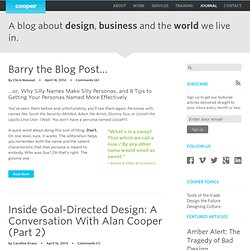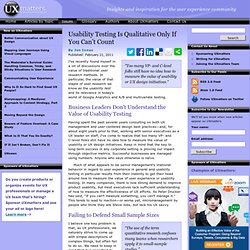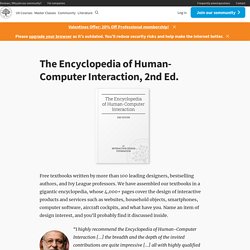

Sripriya
Passionate UX designer
Personas. We continue our conversation with Alan Cooper at Sue and Alan’s warm and welcoming ranch in Petaluma, CA, which, in addition to themselves, is home to sheep and chickens, a cat named Monkey, and a farmer who works the land.

Part 2 brings us up to present-day, and discussions around the applications and fundamentals of Goal-Directed Design that support its success at Cooper and beyond. From Theory to Practice CK: Okay, so having established the foundation of Goal-Directed Design in Part 1 of our conversation, let’s fast forward now to after you started your company, Cooper Software. How has GDD figured in? AC: Basically you find one person, understand their vision and their final desired end state, and then make them ecstatically happy about reaching their end state. CK: Can you say a little more about Personas and their context in the process? AC: Personas are the end result of going out in the field and researching the users and patterns that indicate what their desired end state is. Usability Testing Is Qualitative Only If You Can’t Count. By Jon Innes Published: February 21, 2011 “Too many VP- and C-level folks still have no idea how to measure the value of usability or UX design initiatives.”

I’ve recently found myself in a lot of discussions over the value of traditional user research methods. In particular, the value of that staple of user research we know as the usability test and its relevance in today’s world of Google Analytics and A/B and multivariate testing. Business Leaders Don’t Understand the Value of Usability Testing Having spent the past several years consulting on both UX management and user-centered design best practices—and, for about eight years prior to that, working with senior executives as a UX leader on staff, I’ve come to realize that too many VP- and C-level folks still have no idea how to measure the value of usability or UX design initiatives.
Preaching usability. Wireframing tools. Interesting facts. Comics. Books. New Releases/Trends(Technology) Business Analysis/Project Management. UX/UI repository(design patterns and templates) Agile & UX. Marketing, Business, Online, Social Media. UX/IA. Pearltrees videos. Help. Blogs(Interesting) Interaction-Design.org. Encyclopedia of Usability, HCI, and more. I only have one big research question, but I attack it from a lot of different angles.

The question is representation. How do people make, see and use things that carry meaning? The angles from which I attack my question include various ways in which representations are applied (including design processes, interacting with technology, computer programming, visualisation), various methods by which I collect research data (including controlled experiments, prototype construction, ethnographic observation), and the theoretical perspectives of various academic disciplines (including computer science, cognitive psychology, engineering, architecture, music, anthropology).
If you are based in Cambridge, you may like to attend the following talks on human-computer interaction. This page lists a few large research themes and major projects illustrating them.